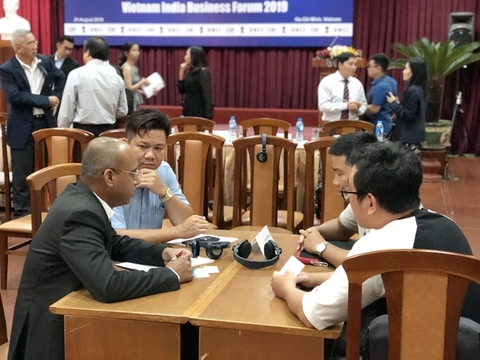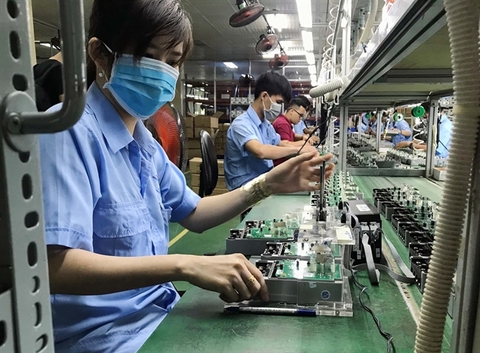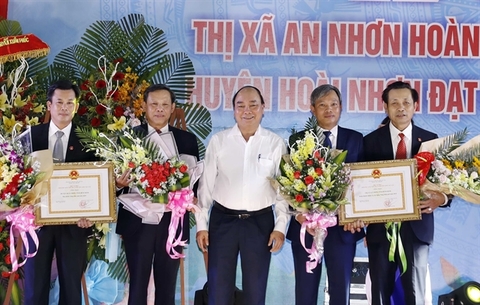Indian, Vietnamese firms discuss trade, investment
Indian, Vietnamese firms discuss trade, investment
Trade and investment ties between Viet Nam and India are not commensurate with their potential, meaning there is still a lot of room for them to grow, the India-Viet Nam Business Forum heard in HCM City on Wednesday.

A visiting 12-member delegation from the Confederation of Indian Industry (CII) led by Joseph Michael Kallivayalil, which is visiting Viet Nam to explore opportunities for economic engagement, investment and trade, took part in the forum.
Vo Tan Thanh, director of the Viet Nam Chamber of Commerce and Industry (VCCI)’s HCM City branch, said India and Viet Nam are both dynamic and rapidly developing economies in Asia.
Trade between the two countries has surged to reach US$10.69 billion last year, and they target $15 billion by 2020, he said.
Pranay Verma, India’s ambassador in Ha Noi, said Indian investments in Viet Nam are worth around $1.7 billion, including investments routed through third countries. They are mostly in energy, mineral exploration, agro-processing, sugar manufacturing, agro-chemicals, IT and auto components.
“Indian investment in Viet Nam is not significant in comparison to India’s cumulative outbound FDI stock that reached $155 billion in 2017.
“We therefore have significant potential that remains untapped.
“The Indian corporate sector has a growing interest in investing in and doing business with Viet Nam, both bilaterally and as a hub for reaching out to East and Southeast Asia.
“Our government is also encouraging Indian companies to invest in Viet Nam. We have set up a project development fund with a corpus of five billion Indian rupees ($80 million) for Cambodia, Laos, Myanmar and Viet Nam to facilitate Indian investment and broaden the manufacturing base of Indian companies in the region.”
The CII is also planning to open an office in HCM City to facilitate investment by Indian companies, he said.
Thanh from VCCI said: “Viet Nam is a promising market with a stable political and economic environment, attractive investment policies, competitive labour costs, availability of raw materials, and potential market access due to free trade agreements that Viet Nam has concluded recently such as the CPTPP and EU-Viet Nam FTA.
“The high growth rate of the Indian economy shows many bilateral development opportunities in areas such as financial services, IT, digital technology, renewable energy, healthcare, tourism and aviation.”
The event, with the participation of leading Indian players in the field of infrastructure construction, information technology, aviation, renewable energy, pharmaceuticals, medical equipment and rubber, was a good opportunity for businesses from the two countries to acquire useful information about trade and investment relations between the two sides, and find business opportunities, he said.
Verma said Vietnamese investment in India is not very large at around $30 million.
“Vietnamese investors can find significant opportunities in India. Indian growth presents opportunities for two-way engagement in financial services, IT, digital economy, hydrocarbons, defence, renewable energy, mining, healthcare, tourism and civil aviation.
“We want Viet Nam to collaborate with us in our flagship programmes - Make in India, Clean India, Start-up India and Digital India.”
Kallivayalil highlighted key areas in which businesses from the two countries could enhance co-operation like education, agriculture, manufacturing, electronics, logistics and construction equipment.
In education, for instance, there is a need to promote tie-ups between universities and academic institutions in the two countries for faculty, research and skill exchanges.
In manufacturing, he said: “Viet Nam offers tremendous opportunities in the manufacturing sector. We need to properly understand its investment laws and taxation policies to facilitate investment from India.
“There is a need to strengthen logistics services between the two countries. India can also access many products manufactured in third countries from Viet Nam at competitive prices and with lesser transportation costs.”
The forum was followed by business-to-business meetings to enable a further exchange of information and co-operation opportunities.

















